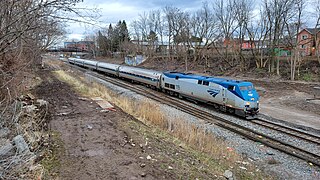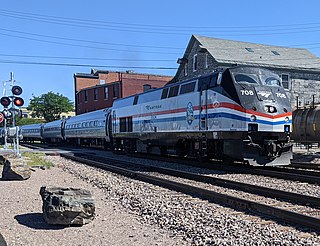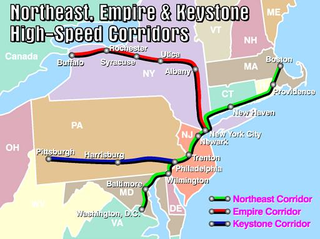
The Maple Leaf is an international passenger train service operated by Amtrak and Via Rail between New York Penn Station in New York City and Union Station in Toronto via Amtrak's Empire Corridor, and the south western part of Via Rail's Quebec City–Windsor Corridor. Daily service is offered in both directions; the 544-mile (875 km) trip takes approximately 12 hours, including two hours for U.S. or Canadian customs and immigration inspection at either Niagara Falls, New York, or Niagara Falls, Ontario. Although the train uses Amtrak rolling stock exclusively, the train is operated by Via Rail crews while in Canada and by Amtrak crews in the United States. Service began in 1981.

The New York Central Railroad was a railroad primarily operating in the Great Lakes and Mid-Atlantic regions of the United States. The railroad primarily connected greater New York and Boston in the east with Chicago and St. Louis in the Midwest, along with the intermediate cities of Albany, Buffalo, Cleveland, Cincinnati, Detroit, Rochester and Syracuse. The New York Central was headquartered in the New York Central Building, adjacent to its largest station, Grand Central Terminal.

The Empire Service is an inter-city rail service operated by Amtrak within the state of New York in the United States. The brand name originated with the New York Central Railroad in 1967. Trains on the line provide frequent daily service along the 460-mile (740 km) Empire Corridor between New York City and Niagara Falls via Albany, the state capital.

The Rutland Railroad was a railroad in the northeastern United States, located primarily in the state of Vermont but extending into the state of New York at both its northernmost and southernmost ends. After its closure in 1961, parts of the railroad were taken over by the State of Vermont in early 1963 and are now operated by the Vermont Railway.

The Ethan Allen Express is a daily passenger train operated by Amtrak in the United States between New York City and Burlington, Vermont, via Albany, New York. One daily round trip is operated on a 310-mile (500 km) north–south route with a 7-hour 35 minute scheduled running time. The train is subsidized by New York and Vermont for the portion north of Albany. It is named for Vermont cofounder and American Revolutionary War hero Ethan Allen.

The Adirondack is a daily intercity passenger train operated by Amtrak between New York City and Montreal. The scenic route follows the Empire Corridor through the Hudson Valley with major stops in Yonkers, Poughkeepsie, Albany–Rensselaer, and Schenectady. North of Saratoga Springs the route runs between the Adirondack Mountains and Lake Champlain until crossing the Canada–U.S. border at Rouses Point. Trains take approximately 11 hours to travel the 381-mile (613 km) route.

The Delaware and Hudson Railway (D&H) is a railroad that operates in the Northeastern United States. In 1991, after more than 150 years as an independent railroad, the D&H was purchased by the Canadian Pacific Railway (CP). CP, which would itself become part of Canadian Pacific Kansas City in 2023, operated D&H under its subsidiary Soo Line Corporation, which also operates Soo Line Railroad.

The Empire Corridor is a 461-mile (742 km) passenger rail corridor in New York State running between Penn Station in New York City and Niagara Falls, New York. Major cities on the route include Poughkeepsie, Albany, Schenectady, Amsterdam, Utica, Syracuse, Rochester, and Buffalo. Much of the corridor was once part of the New York Central Railroad's main line.

Rhinecliff station is an Amtrak intercity rail station located in the Rhinecliff hamlet of Rhinebeck, New York, United States. The station has one low-level island platform, with a wheelchair lift for accessibility. It is served by the Adirondack, Berkshire Flyer, Empire Service, Ethan Allen Express, Lake Shore Limited, and Maple Leaf.

The Empire State Express was one of the named passenger trains and onetime flagship of the New York Central & Hudson River Railroad. On September 14, 1891, it covered the 436 miles (702 kilometers) between New York City and Buffalo in 7 hours and 6 minutes, averaging 61.4 miles-per-hour (98.8 km/h), with a top speed of 82 mph (132 km/h).

Whitehall station is an Amtrak intercity train station in the village of Whitehall, New York. It is served by the Adirondack. It has one low-level side platform with a small shelter on the east side of the track.

Ticonderoga station is an Amtrak intercity train station in Ticonderoga, New York. It is served by the single daily round trip of the Adirondack. The station is located about 2 miles (3.2 km) east of downtown Ticonderoga and 0.2 miles (0.32 km) west of the Fort Ticonderoga–Shoreham Ferry landing. It has one low-level side platform on the west side of the single track.

Rouses Point station is an Amtrak intercity train station in Rouses Point, New York, served by the single daily round trip of the Adirondack. The station building is a former Delaware and Hudson Railway constructed in 1889, with a one low-level side platform on the east side of the track. It was added to the National Register of Historic Places in 2005 as Rouses Point Railroad Station.
The Green Mountain Flyer was an international day train between Montreal, Quebec, Canada, and the Northeast United States, with sections to New York City and Boston. It was operated in cooperation between the Rutland Railroad, the Canadian National Railway and the New York Central Railroad. The train carried the number 65 running north, and number 64 running south. The Mount Royal was the night train counterpart to the Green Mountain Flyer. Following years of cutbacks, both trains were discontinued in 1953 when the Rutland Railway ended all passenger service.

Union Station was the main passenger railroad station of Troy, New York until it went out of service in 1958. A Beaux-Arts building, designed by Reed & Stem and completed ca. 1903, it served the New York Central Railroad (NYC), the Boston and Maine Railroad (B&M) and the Delaware and Hudson Railroad (D&H). This was the fourth union station in Troy. The tracks approaching the station were but feet away from homes. It stretched from Broadway to Fulton streets, on the block east of Union Street.
The North Star was a named night train, train #21, 1947–1962, of the New York Central Railroad (NYC) that went from Grand Central Terminal of New York City to Union Terminal of Cleveland, Ohio. It was distinctive in the history of the New York Central's history of service to the North Country of New York State, because it was the longest lasting train in the NYC's later decades that hosted sleeping cars that went continuous from New York City to Lake Placid in the Adirondacks. Predecessor trains in the pre-World War II period carrying direct sleeping cars to the Adirondacks included the Niagara (#29) and the Ontarian.
The Freight Subdivision is a railway line in the New York. It runs from Schenectady, New York, to Mechanicville, New York. It was built by the Delaware and Hudson Railway in 1881 as a freight-only bypass, connecting with the main line of the Boston, Hoosac Tunnel and Western Railway. Today, Canadian Pacific Kansas City owns the line.
The Whitehall and Plattsburgh Railroad was a railway company that built but did not operate two disconnected railway lines in Upstate New York in the 19th century. Its purpose, to build a 90-mile (140 km) railway line between Whitehall, New York, and Plattsburgh, New York, was realized by its successor, the New York and Canada Railroad, albeit over a different route between Port Henry, New York, and Plattsburgh. Its northern line, between Plattsburgh and Ausable, New York, became the Ausable Branch of the Delaware and Hudson Railway and was abandoned in 1981. Its southern line, between Port Henry and Ticonderoga, New York, was incorporated into the New York and Canada Railroad main line and today is part of the Canadian Pacific Kansas City's Canadian Subdivision.
The New York and Canada Railroad was a railway company that operated in the state of New York between 1873 and 1908. It was established to consolidate existing companies in the northern part of the state and to complete a north–south railway line along the west side of Lake Champlain. Through service to Plattsburgh, New York, began in 1875, and the company later extended further north to Rouses Point, New York (1876), and to the Canadian border (1906). Always under Delaware and Hudson Railway control, the company was formally merged in 1908. Today, the Lake Champlain line is part of the Canadian Pacific Kansas City's Canadian Subdivision.
The Canadian Subdivision is a railway line in the state of New York. It runs north–south along the west side of Lake Champlain from the vicinity of Schenectady, New York, to Rouses Point, New York, on the border with Quebec. While the oldest part of the line was built in 1832–1833, the majority was constructed between 1869 and 1876. Once part of the Delaware and Hudson Railway main line, today Canadian Pacific Kansas City owns the line. Amtrak's Adirondack operates over the full length, providing daily service between New York City and Montreal.















